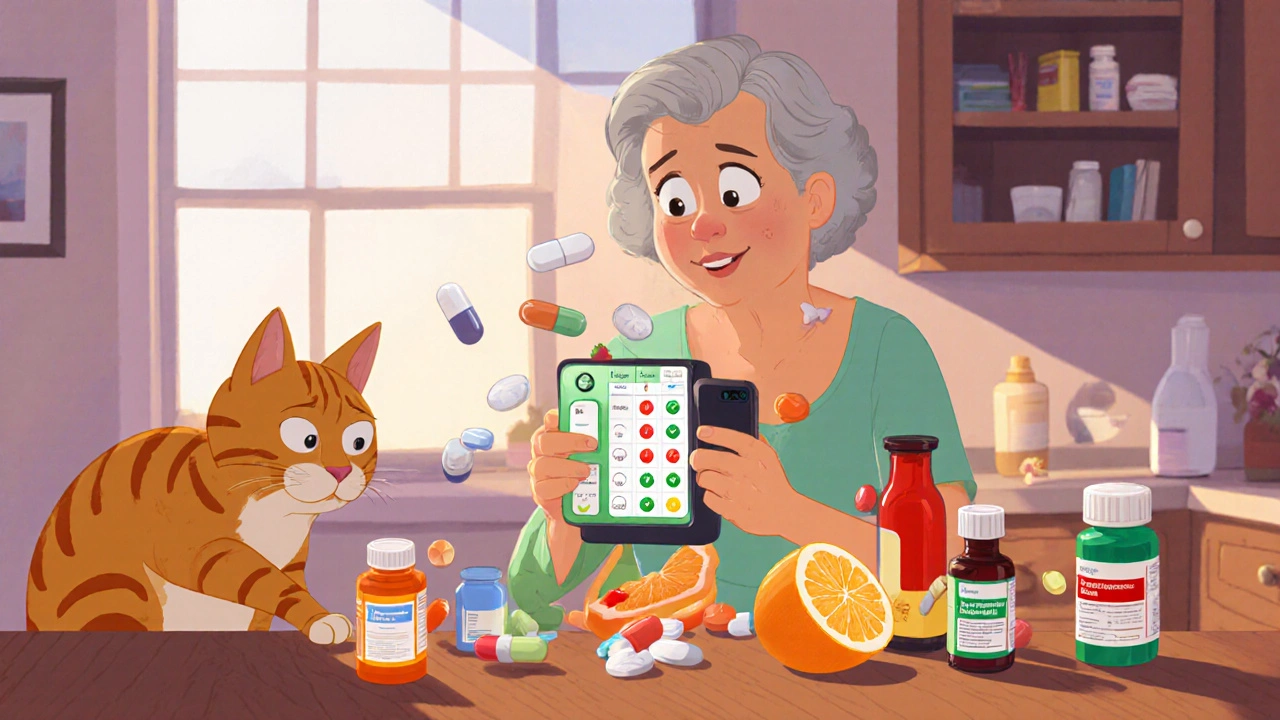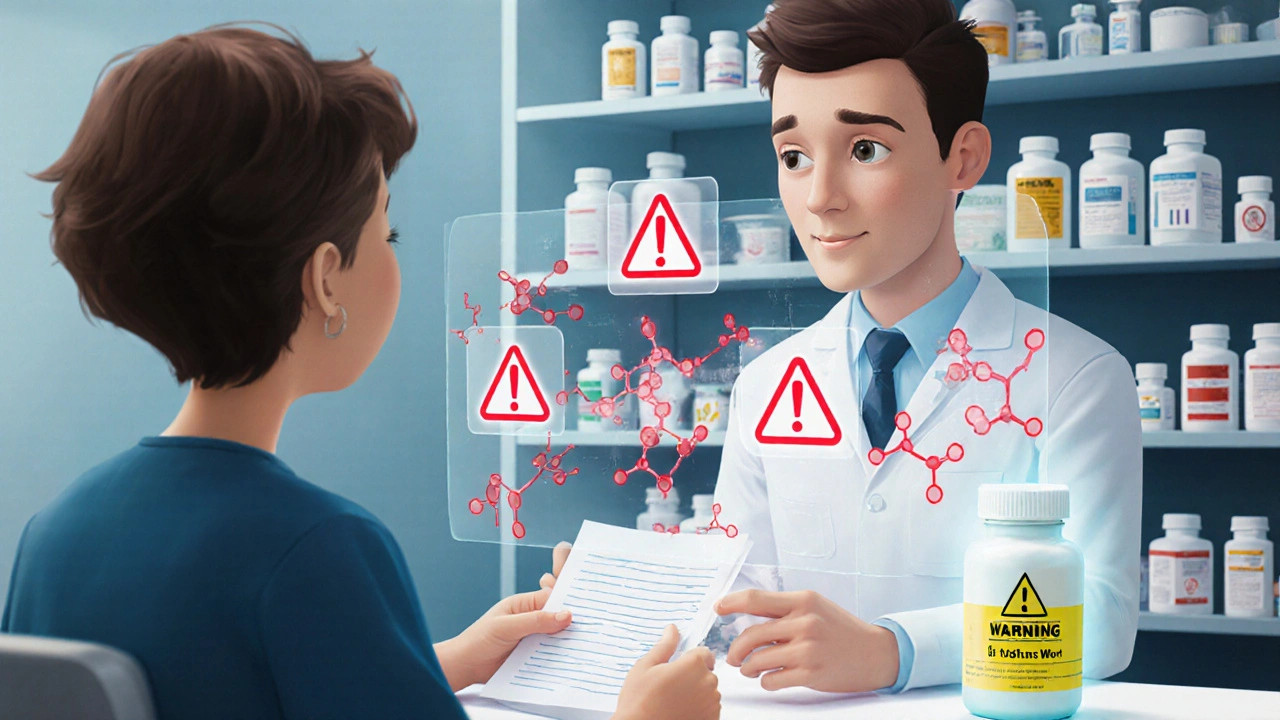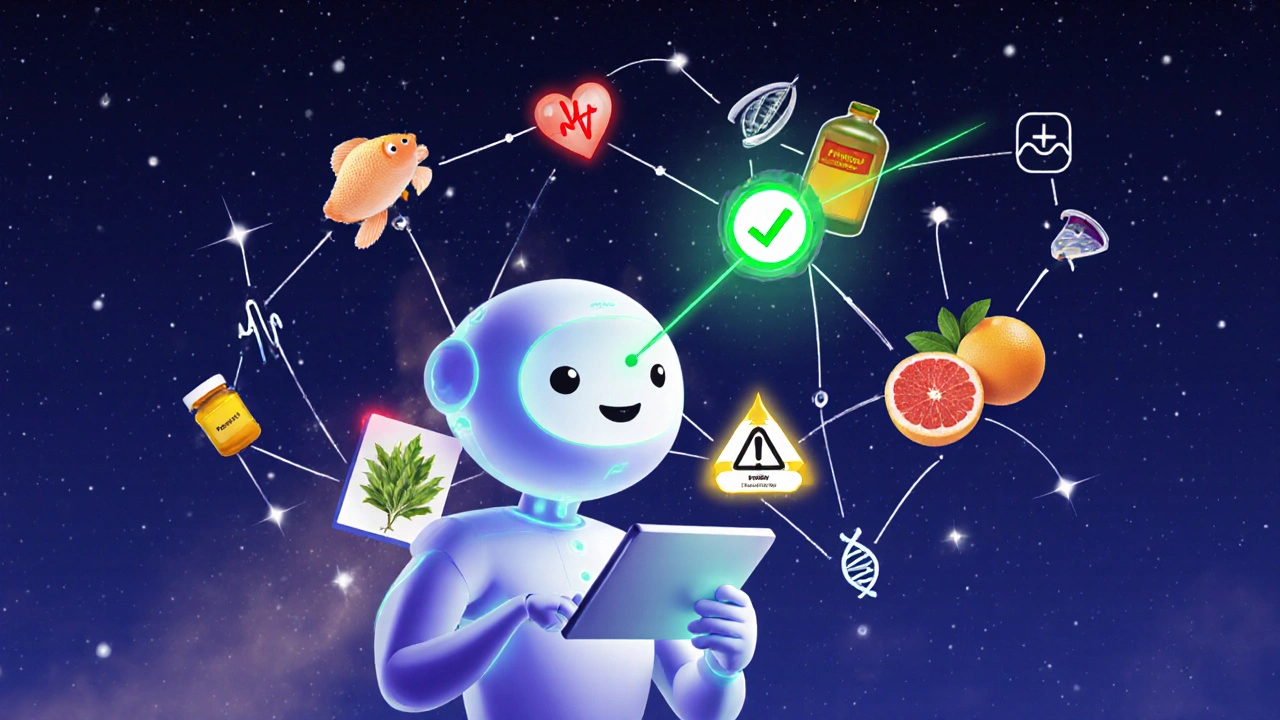How to Use a Drug Interaction Checker Tool Effectively
 Nov, 18 2025
Nov, 18 2025
Why drug interaction checkers matter more than ever
More than half of adults over 65 take five or more medications every day. That’s not just common-it’s dangerous if you don’t know what happens when those drugs mix. A drug interaction checker isn’t a luxury. It’s a basic safety tool, like checking your car’s oil before a long trip. These tools scan your pills, supplements, and even foods to spot hidden dangers: one drug making another useless, or two together causing dizziness, bleeding, or heart trouble. The World Health Organization says nearly 7% of hospital visits are caused by bad drug reactions. Most of those could’ve been caught with a simple check.
How drug interaction checkers actually work
These tools don’t guess. They compare your medications against databases built from decades of clinical studies. They look for three main problems: drug-drug (like warfarin and ibuprofen causing bleeding), drug-food (like grapefruit making cholesterol meds too strong), and drug-condition (like decongestants raising blood pressure in people with heart disease). The best tools use color codes to show risk levels: red means stop, orange means watch closely, yellow means keep an eye out, and green means it’s safe.
For example, the University of Liverpool’s COVID-19 Drug Interactions Checker uses this system to flag dangerous combos with Paxlovid. It’s updated every week with new data. That’s why it’s trusted by doctors across the UK and US. But not all tools are built the same. Some miss interactions because they don’t include herbal supplements or over-the-counter meds-things people often forget to mention.
Which drug interaction checkers actually work
Not all free apps are created equal. A 2016 study by the National Institutes of Health tested five major tools. Here’s what they found:
| Tool | Accuracy Rate | Sensitivity (catches real risks) | Specificity (avoids false alarms) | Best For |
|---|---|---|---|---|
| Lexi-Interact | 77% | 77% | 72% | Hospitals, professionals |
| Micromedex | 78% | 70% | 78% | Clinical decision-making |
| iFacts | 98% | N/A | N/A | Comprehensive drug lists |
| Epocrates | 60.3% | 60% | 58% | Quick mobile checks |
| Medscape | 49% | 49% | 47% | General reference |
| Drugs.com | ~65% | Good | Good | Patients, supplements |
| WebMD | ~60% | Medium | Medium | Easy access |
For most people, Drugs.com is the best free option. It includes herbal supplements, which many clinical tools ignore. It’s simple, works on phones, and flags interactions like St. John’s Wort reducing birth control effectiveness. Hospitals use Lexi-Interact and Micromedex because they’re more thorough-but they’re not free. If you’re on multiple meds, use two tools. A 2022 study found that combining two checkers catches 15-20% more dangerous interactions than using just one.

What most people get wrong when using these tools
People think a green light means it’s 100% safe. It doesn’t. No tool catches every interaction. Studies show even the best systems miss 10-15% of real risks, especially with new drugs or complex combinations. A 2022 case in the Journal of Patient Safety showed a patient using a free checker that missed a deadly combo between sertraline and linezolid. That mistake led to serotonin syndrome-a life-threatening condition.
Another big mistake? Forgetting supplements. About 23% of serious interactions involve vitamins, herbs, or CBD. Epocrates and Medscape often leave these out. If you take turmeric, fish oil, or melatonin, you need a tool that includes them. Drugs.com does. WebMD does. Many hospital systems don’t.
And don’t rely on the tool alone. A 2021 Harvard study found that 32% of alerts from hospital systems are false alarms-warnings that sound scary but don’t matter in real life. If you see a red flag, don’t panic. Don’t stop your meds. Call your pharmacist.
How to use a drug interaction checker step by step
Follow this simple three-step process:
- Make a complete list of everything you take: prescriptions, over-the-counter painkillers, vitamins, herbal teas, even topical creams. Write down the exact names-brand and generic. Don’t skip the magnesium you take for sleep or the ginseng you use for energy.
- Enter each item into a trusted checker. Use Drugs.com or WebMD if you’re a patient. Use Lexi-Interact or Micromedex if you’re a healthcare provider. Input them one at a time. Don’t rush. Check for typos. “Metoprolol” isn’t the same as “Metoprolol tartrate.”
- Review results with a professional. If you see red or orange alerts, print them out or show them on your phone to your pharmacist. Ask: “Is this a real risk for me?” They know your history, your kidneys, your liver, your other conditions. No app can replace that.
It takes 15-20 minutes. That’s less time than scrolling through social media. But it could save your life.
When to skip the tool and call your pharmacist
You don’t need a checker if you’re taking just one or two meds. But if you’re on five or more, or if you’ve been hospitalized recently, you need human help. The FDA says no tool replaces a pharmacist’s review for complex regimens. That’s especially true if you’re over 65, have kidney or liver disease, or take blood thinners, seizure meds, or antidepressants.
Also, if you’ve just started a new drug-like a cancer treatment or a new heart medication-wait 48 hours before trusting any checker. New drugs often aren’t in databases yet. The University of Liverpool’s tool updates weekly, but most consumer tools lag by months.
And if you’re pregnant, breastfeeding, or caring for a child, skip the free apps entirely. Use a pharmacist. The risks are too high to guess.

What’s coming next in drug safety tech
Tools are getting smarter. Epic Systems just launched InteractionGuard, which checks not just what you take, but when you take it. It spots if you’re taking two drugs at the same time that should be spaced apart. AI is being trained on millions of adverse event reports to predict new interactions before they’re officially documented. One NIH project showed a 18% improvement in detection using machine learning.
But the core truth won’t change: technology helps, but doesn’t replace judgment. The best drug interaction checker is still a trained pharmacist with a patient’s full history in front of them. Your job? Use the tools to be informed. Then bring that info to your pharmacist. Don’t just check. Confirm.
Final tip: Keep your list updated
Every time you start or stop a medication-whether it’s a new antibiotic, a sleep aid, or a new supplement-update your list. Keep it in your wallet, on your phone, or taped to your fridge. Share it with every doctor, every time. That’s how you stop bad interactions before they start.
Can I trust free drug interaction checkers like WebMD or Drugs.com?
Yes, but with limits. Drugs.com is one of the most accurate free tools and includes supplements, which many clinical tools miss. WebMD is decent for basic checks but misses some interactions. Neither catches every risk, and none replace professional advice. Use them as a first step-not the final word.
Do drug interaction checkers work for herbal supplements?
Some do, some don’t. Tools like Drugs.com and WebMD include common herbs like St. John’s Wort, garlic, and ginkgo. But many hospital systems and apps like Epocrates ignore them. Since 23% of serious interactions involve supplements, always pick a checker that lists them. If it doesn’t, assume it’s incomplete.
Why do I get so many alerts on my hospital’s drug checker?
Because clinical tools like Lexi-Interact are designed to catch every possible interaction-even the unlikely ones. Studies show up to 45% of alerts in hospitals are false positives. That’s called “alert fatigue.” Don’t ignore them, but don’t panic either. Always ask your pharmacist: “Is this actually dangerous for me?”
Can a drug interaction checker prevent all adverse reactions?
No. Even the best tools miss 10-15% of interactions, especially with new drugs, rare combinations, or complex health conditions. The most accurate systems still only catch 85-90% of risks. That’s why pharmacists are essential. Tools are aids-not replacements-for clinical judgment.
Should I use more than one drug interaction checker?
Yes, especially if you take five or more medications. A 2022 study showed that using two different checkers catches 15-20% more dangerous interactions than using just one. Try Drugs.com and WebMD together. If you’re a healthcare provider, use Lexi-Interact and Micromedex side by side. Don’t rely on a single source.
What should I do if a drug interaction checker flags a red alert?
Don’t stop your medication. Don’t ignore it. Print the result or show it on your phone and call your pharmacist immediately. They can tell you if the risk is real for your body, your age, your other conditions, and whether there’s a safer alternative. Red alerts are warnings-not orders.
Are drug interaction checkers useful for people under 65?
Absolutely. Even young adults taking birth control, antidepressants, or antibiotics can have dangerous interactions. For example, the antibiotic linezolid can cause serotonin syndrome if taken with SSRIs like sertraline. Age doesn’t protect you. If you take more than three medications or any supplements, use a checker.
How often should I check for drug interactions?
Every time you start, stop, or change a medication-even a small change like adding a new vitamin. Also check every six months if you’re on a stable regimen. Drug databases update constantly, and your body changes over time. What was safe last year might not be safe now.
Next steps: Protect yourself today
Go to Drugs.com right now. Type in every medication and supplement you take. Look at the results. If you see anything red or orange, write it down. Bring it to your next pharmacy visit. Ask your pharmacist to check it against their system. That’s all it takes. You don’t need to be an expert. You just need to be careful.